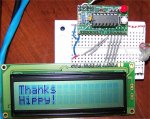I have a 16x2 lcd with a 14m picaxe. In the getting started manual 3 it has a diagram of the different ways you can interface the lcd with the chip. Well every one shows an 18 pin picaxe and it's just not working out for me.
Ive looked all over but all I see listed are 8pin picaxe chips, 18 and I think it was 28. Right now what I have tried is;
LCD PICAXE14M
Pin11 (DB4) - output pin 5
Pin12 (DB5) - output pin 4
Pin13 (DB6) - output Pin 3
Pin14 (DB7) - output pin 2
Pin6 ( E ) - output pin 1
Pin4 ( RS ) - output pin 0
Then
Pins 16 and 1 - 0v
Pins 15 and 2 - +4.5
I get 16 box's to light up on the left. The other half stays unlit.
I think all I need right now is the proper wiring. Help?
Ive looked all over but all I see listed are 8pin picaxe chips, 18 and I think it was 28. Right now what I have tried is;
LCD PICAXE14M
Pin11 (DB4) - output pin 5
Pin12 (DB5) - output pin 4
Pin13 (DB6) - output Pin 3
Pin14 (DB7) - output pin 2
Pin6 ( E ) - output pin 1
Pin4 ( RS ) - output pin 0
Then
Pins 16 and 1 - 0v
Pins 15 and 2 - +4.5
I get 16 box's to light up on the left. The other half stays unlit.
I think all I need right now is the proper wiring. Help?

